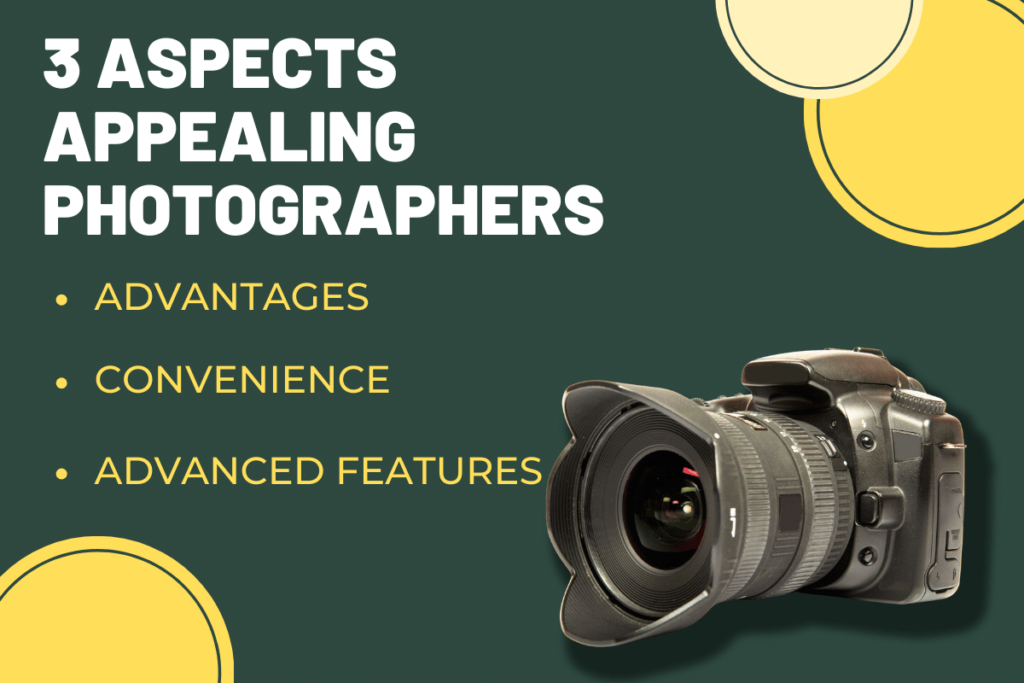
Digital cameras revolutionized photography by offering instant gratification. You could see your shot right away, make adjustments, and try again, all without wasting film.
They also unlocked a world of possibilities with features like high storage capacity and the ability to tweak settings on the fly. You weren’t just taking pictures; you were crafting images with unprecedented control and creativity.
And let’s not forget the ease of sharing. Gone were the days of developing rolls of film. With digital cameras, you could share your latest masterpiece with the world in a matter of seconds. It’s no wonder photographers were quick to embrace this game-changing technology.
Evolution of Photography
From Film Cameras to Digital Cameras
Remember the anticipation of waiting for your photos to be developed from a roll of film? Those days feel almost like a distant memory now. Digital cameras changed the game and with that, the entire landscape of photography was transformed. Here’s a stroll down memory lane and a peek at what pushed photographers toward the digital realm.
Back when film dominated, you had to be strategic with each shot. You had a limited number of frames—24 or 36 for most rolls—and snapping a photo required more forethought. But then digital cameras arrived, and they brought with them the promise of unlimited captures. You could take hundreds, even thousands of photos, without worrying about running out of film or the cost implications of developing each shot.
Digital cameras offered immediate feedback through their LCD screens, a feature that rocketed them to the top of every photographer’s wish list. Gone were the days of waiting days or weeks to see your images. With a digital camera, you could review your work on the spot, learn from your mistakes, and try again — all without wasting a single frame.
Beyond the immediate feedback, digital cameras provided a level of control and creativity that was unmatched in the film camera era. From adjusting ISO to experimenting with shutter speed and aperture, these settings could be modified at will to get the perfect shot. Not to mention, the various processing options that were now at your fingertips. All those filters and photo editing software? They became part of the photographer’s toolkit, further cementing digital cameras’ appeal.
Photographers were drawn to digital cameras as they represented a leap toward freedom—a freedom to experiment, to make mistakes, and to hone their craft on the fly. The fear of a wasted roll of film was replaced by the reassurance that digital storage offered. Memory cards, and later cloud storage, could hold vast collections of images, accessible anywhere, at any time.
And let’s not overlook the ease of sharing digital photos. In the film era, you had to make prints and physically hand them out or mail them to others. Digital images could be shared instantly, with a wide audience, magnifying the photographer’s reach and impact. This connectivity not only fostered a community of photographers online but also created an entirely new dynamic in the way we consume and appreciate photography.
Advantages of Digital Cameras
Image Quality
Once upon a time, digital cameras were the new kids on the block, and many were skeptical about their image quality—especially when compared with their film counterparts. Fast forward to today, and it’s a whole different story. Digital cameras now boast incredibly high resolutions—we’re talking about staggering numbers of megapixels that capture every tiny detail with pinpoint accuracy. Your photos not only look crisp but with advancements in sensor technology, they’re bathed in excellent dynamic range and low-light performance. You can snap shots in a dim cafe and still capture the mood without that grainy noise intruding.
Instant Feedback
Remember the agonizing wait to get your film developed? Digital photography kissed that goodbye. The moment you take a picture, the LCD screen becomes your best buddy, providing instant feedback. This gem lets you review your work right away. If that shot of the sunset didn’t quite capture the oranges and pinks the way you wanted, no sweat—you can reshoot until it’s just right. It’s that instant gratification that lets you learn and improve on the fly, skyrocketing your skills as a photographer without delay.
Cost Savings
Let’s talk numbers for a moment. Film photography had its charm, but every click of the shutter was a bit of a gamble with your wallet. Those film rolls and development costs added up, didn’t they? With digital, you’ve got unlimited captures at no extra cost. No more “Is this scene worth a shot?”—now, the world is your oyster, and you’re freed up to snap shots galore. Plus, think of all the coffee you can buy with the money you’re saving!
Creative Control
Here’s where things get exciting. Digital cameras hand over the reins of creative control to you, the photographer. You’re no longer at the mercy of film processing for the final look of your photos. Your artistic flair can shine through with on-the-fly adjustments to exposure, white balance, and ISO settings. Get this—you even get to play the wizard in post-processing, conjuring up the mood and feel you envisioned. With a digital camera, you’re not just taking photos; you’re crafting stories, and each one’s unique because you’ve poured a bit of soul into it.
There you have it—digital cameras are not just gadgets; they’re the allies that amplify your talents, transform your experiences, and ultimately, shape how you capture life’s fleeting moments. Now go on, keep exploring what aspects made digital cameras so incredibly appealing to photographers and watch your artistry flourish.
Convenience of Digital Cameras
Portability
Imagine heading out on an adventure, feeling the excitement bubble up at the thought of capturing memories that’ll last a lifetime. Now, picture yourself doing that without the hefty gear. Here’s where the portability of digital cameras becomes a game changer. They say good things come in small packages, and with the advent of compact digital cameras, you can live by that adage. No more lugging around bulky camera bags – just pop your digital companion in your pocket, and you’re good to go! Modern digital cameras pack powerful features into slim designs, making it effortless for you to bring your creative eye wherever you roam.
Storage Capacity
Ever been in that moment where you’re about to take the perfect shot and see the dreaded “memory full” warning? Well, wave goodbye to those days. With digital cameras, you’ve got storage capacity that seems to stretch as far as the eye can see. Throw out the old film limitations where you’d anxiously ration each click. Now, a single memory card can hold thousands of high-resolution images. The beauty here is in the numbers:
| Memory Card Size | Estimated Number of Photos* |
|---|---|
| 16GB | 500-1,000 |
| 32GB | 1,000-2,000 |
| 64GB | 2,000-4,000 |
| 128GB | 4,000-8,000 |
*Estimates for 10-12 megapixel JPG images.
Just swap out the card when it’s full, and keep shooting. No hassle, no waiting, and definitely no missing out on those once-in-a-lifetime shots.
Easy Sharing
What’s the point of capturing all those stunning images if you can’t flaunt them? Digital cameras understand the assignment – they make easy sharing part of the package. Back in the days of film, showing your latest snaps meant long hours in the darkroom or the one-hour photo wait. Now, it’s as straightforward as connect, click and share. Whether it’s via a USB cable, memory card, or wireless connectivity like Wi-Fi and Bluetooth, you can beam your images across devices or upload them directly to social media at lightning speed. The instant gratification of sharing your visual storytelling is one of the most appealing aspects of digital photography, connecting you with friends, family, and followers across the globe in a flash.
Advanced Features of Digital Cameras
Manual Controls
Take full command of your photography with manual controls on your digital camera. Ever felt like you’re juggling too much automation? Flip the switch to manual mode. Here, you’re in charge of the aperture, shutter speed, and ISO. This hands-on approach lets you tweak your settings for that just-right shot. It’s empowering, isn’t it? No more letting your camera call the shots—a true photographer like you knows that precision matters.
Imagine capturing the blur of a waterfall with a slow shutter speed, or freeze-framing a hummingbird’s rapid wing beats. It’s all possible when you maneuver the settings to fit the scene in front of you. Manual controls are an avenue where your creativity meets technology, and it’s one reason what aspects made digital cameras appealing to photographers in the first place.
Extended Zoom
Picture this: a soaring eagle in a boundless blue sky. With your digital camera’s extended zoom, it’s not just a speck in the distance. Bring the action closer without physically moving an inch—a game-changer for wildlife and sports photography. High-powered zoom lenses have made it a breeze to capture intricate details from afar, turning near-impossible shots into your next great photo. Think about it—no heavy gear to lug around, just the power of your zoom to encapsulate the majesty of distant subjects.
The balance of portability and power found in the extended zoom of digital cameras has reshaped photography. It’s like having a microscope and a telescope in your pocket, ready to reveal the grains of the macro world or the grandeur of the cosmos.
Image Stabilization
Ever taken a photo only to see it marred by the dreaded blur of camera shake? Enter image stabilization. This nifty feature helps you snap crystal-clear images, even with shaky hands or in low light conditions. It compensates for movement, giving you a fighting chance against the blur. No tripod? No problem. Whether it’s an impromptu street performance or a bird taking flight, the spontaneity of life won’t escape your lens.
Photographers love this because it means more keepers and fewer discarded shots. Plus, it’s essential for those who can’t resist the urge to capture nightlife or the twinkle of stars. Image stabilization has undeniably added to the robust appeal of digital cameras, letting you push the boundaries of where and when you can shoot with confidence.
As you’ve seen, the appeal of digital cameras to photographers is rooted in the powerful features they offer, like manual controls, extended zoom, and image stabilization. Continue exploring how these tools can enhance your photographic prowess and open up a world of visual storytelling possibilities.
Conclusion
You’ve seen just how digital cameras revolutionize the art of photography with their advanced features. The freedom to tweak your settings and the convenience of extended zoom without extra weight are game changers. Not to mention, image stabilization ensures your memories are captured with clarity, no matter the conditions. It’s these innovations that have made digital cameras not just tools, but companions for your creative journey. Now, go out there and let your imagination capture the world in ways only you can envision!
Frequently Asked Questions
What are the primary advantages of digital cameras?
Digital cameras offer advanced features such as manual controls for aperture, shutter speed, and ISO, extended zoom capabilities, and image stabilization, which enable photographers to have greater creative freedom and capture clearer images in diverse conditions.
How do manual controls benefit photographers?
Manual controls allow photographers to adjust settings like aperture, shutter speed, and ISO, giving them full command over the exposure and artistic aspects of their photography, which is essential for both inexperienced and professional photographers.
Why is extended zoom important in digital cameras?
Extended zoom allows photographers to capture distant subjects closely without carrying heavy gear. This feature is particularly useful for photographing wildlife, sports, and other scenarios where getting physically close to the subject is challenging.
What is image stabilization and why is it useful?
Image stabilization is a technology that compensates for camera shake, making it possible to take clearer pictures at slow shutter speeds or when shooting without a tripod. It is especially beneficial in low light conditions or when using telephoto lenses.

